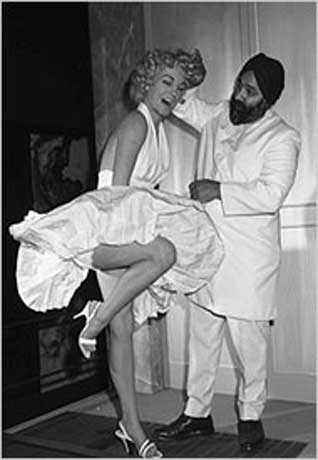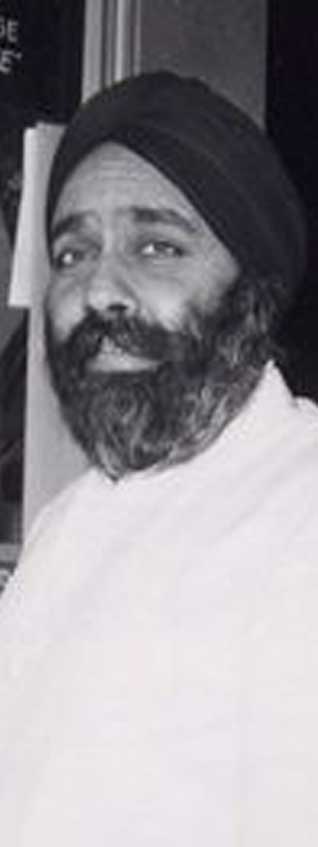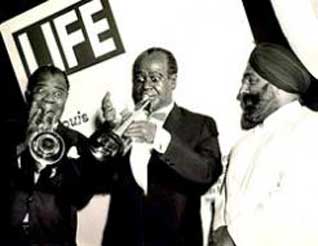Sapuran Singh Sundher -- popularly known as 'Spoony Singh' -- was the founder of the Hollywood Wax Museum. A canny but star-struck entrepreneur, his brainstorm was to offer gawking Hollywood tourists wax statues of movie stars since the real ones were obligingly sparse.
Sapuran Singh had an outsize personality, reflected in his riding an elephant in Hollywood parades and prospecting successfully for gold in Mexico. But his big idea came in 1964 as he traipsed along Hollywood Boulevard and saw no sign of celebrities -- save their famous footprints by Grauman’s Chinese Theater -- leading him to realize that a wax museum was the next best thing.
When his Hollywood Wax Museum opened on February 26, 1965, a half-mile-long line of people waited to get in, to be followed by 300,000 or so a year for many years. Even as the price of admission has risen to $15.95 from $1.50, more than eight million people have visited.
Spoony Singh’s showmanship was legendary. He once dressed all his employees like London bobbies; had an actor made up like Charlie Chaplin to serve as a greeter; and dispatched skateboarders in gorilla suits to cruise in front of the museum. He had breathing people jump up from amid the wax ones to scare the customers, until his lawyers panicked about possible lawsuits.
Perennial favorites at the museum include John Wayne and Marilyn Monroe. Each year, some stars are added and others subtracted; Leonardo DiCaprio and Catherine Zeta-Jones now occupy prominent positions. Stars occasionally appear at the museum to see themselves, sometimes demanding a sartorial makeover.
The number of figures has shrunk to 180 from 220 as space has been given to entire movie scenes. (Hitler was removed for another reason: workers tired of cleaning off the spittle.)
Paradoxically, the Hollywood Wax Museum benefited from a perception that some of its figures were less than perfect and seemed a little surreal in the eerie light. In 1995, The Los Angeles Times lauded the “sense of old-time Hollywood decadence that is soulful and deeply satisfying.”
The Web site Citysearch called the museum “beyond the realm of campy,” saying it represented “classic Hollywood schlock at its best and worst.” To some, the replicas of Jesus and his disciples at the Last Supper, with visitors’ pennies strewn all over the table, contributed to this impression.
In an interview with The Los Angeles Times in 1970, Spoony Singh admitted readily that other museums were statelier. “On Hollywood Boulevard,” he said, “dignity kind of gets lost in the shuffle.”
Sapuran Singh Sundher was born on Oct. 20, 1922, in Jalandhar, Punjab. When he was 2, his family sailed to Vancouver, Canada. They moved to Victoria on Vancouver Island, and his father found work in the lumber industry. Although young Sapuran was admitted to college, he went to work in sawmills and timber camps at 17 after his father developed asthma.
He scraped together money to buy a truck to transport shingles, then parlayed that into part ownership of a sawmill and a logging camp. He put together an amusement park, building the go-carts himself using motors from chainsaws. He added attractions like trampolines and a restaurant.
One day in Victoria, he had cocktails with some businessmen, including a circus owner who owned some wax figures and suggested that Sapuran start a wax museum in Vancouver. Sapuran thought the idea might work elsewhere, and in 1964 he found a 15,000-square-foot Hollywood building that housed a luggage shop and a women’s undergarment factory. He signed a 20-year lease and decided to specialize in movie stars.
To publicize the museum, he scrambled to find ways to meet people, like attending rehearsals of “The Lawrence Welk Show” and hanging out at the Magic Castle, a magicians’ gathering place. The museum began to be mentioned on television by Johnny Carson, Bob Hope and Red Skelton.
Later, Spoony Singh opened, and closed, two more wax museums, one in Solvang, California, and the other in San Diego. In 1991, he opened the Hollywood Guinness World of Records Museum.
In the mid-1990’s, with Spoony Singh’s guidance, his family opened a branch of the Hollywood Wax Museum in Branson, Missouri. Its 150-foot-long outdoor sculpture of the faces of Wayne, Elvis Presley, Monroe and Chaplin, made to resemble Mount Rushmore, was his idea.
Sapuran Singh died of congestive heart failure on October 18, 2006 at his home in Malibu, California. He was 83.
Sapuran Singh is survived by his wife of 63 years, Chancil Kaur; four sons, Jehlam Singh and Raubi Singh, of Malibu, Kabir Singh, of Los Angeles, and Meva Singh, of Victoria; two daughters, Janik Kaur Hundal and Indie Kaur Moghaeddam, both of Los Angeles; and 11 grandchildren.
In an interview with a wire service, Raubi Singh spoke of his father’s quirky creativity. He said that if a light bulb had gone on every time his father had had an idea, there would have been no electricity left in the world.
“There’s actually no better tribute,” Raubi Singh said, “than our flashing neon sign that lights up Hollywood Boulevard every night, 365 days a year.”
November 13, 2013





